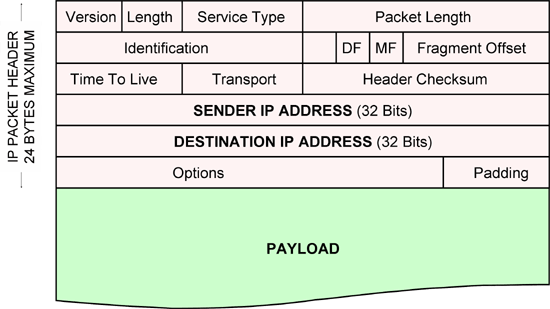The Internet Protocol (IP) is part of the TCP/IP suite of protocols developed by the US military and now used on the Internet, on carrier networks and on business systems. IP is a network protocol, defining the network address and packet format. An IP network address is the equivalent of a telephone number.
IP was originally the Inter-net protocol, developed beginning in the late 1960s as a common format for communication across existing networks that used various different packet formats. Subsequently, IP took over, and today there aren't really any different kinds of packet networks, pretty much all packet networks use IP as their native format.

The term packet means a segment of data, the "payload" in the diagram above plus network control information added on the front. The data can be literally anything: a piece of an email message, a piece of a web page, digitized voice for telephone calls, video in all its forms, Google maps data, anything.
A packet network is formed by connecting circuits going to different locations with network equipment called routers. Routers relay or forward packets from an incoming circuit to an outgoing circuit. Knowing which outgoing circuit to forward a packet on is the routing part of the story.
The IP address identifies the final destination of a packet. This information is used by routers to decide where to go next at each router.
Communication from one network user to another is implemented by the sending user creating a packet and transmitting it to the closest router. The router forwards the packet to another router, to another router, and so forth, and the last router in the chain finally forwards the packet to the destination user.
Many times, one of these "users" is a server, for example, a web server, an email server or a video server. For a Voice over IP phone call, both users have IP telephones.
The header is the "network control information" pasted on to the front of the segment of data to be sent over the network. Another way of saying this using jargon is that the segment of data is encapsulated in IP.
The diagram illustrates the elements in the IP version 4 (IPv4) header including the Don't Fragment (DF) field and the More Fragments (MF) field which are used to control whether the block of data to be sent over the network can be divided into a number of segments, one segment per packet, or not, and whether this has actually happened or not.
The most interesting part of the IP header is the source (sender) IP address and the destination IP address.
IP is published as military standard MIL-STD-1777, and updated in various Request for Comment (RFC) documents which are the Internet version of a standard. IP version 4 with 32-bit addresses is currently in use. IP version 6 (IPv6) with 128-bit addresses is next.
Using IP implements a connectionless network service, which means that at the network level, there is no communication with the receiver. Packets are sent off on the network to fend for themselves. There are no guarantees that the packets will be delivered. There is no error check on the data being carried in the packet.
A higher-level protocol is required to perform error checking and to deal with packets that are not delivered. This is usually implemented with TCP... but that's a different lesson.
Related Courses
Since IP packets and addresses are part of the fundamentals of telecom, this discussion is included in most of Teracom's training courses.
These topics are covered in online certification courses:- TCO CTNS Certified Telecommunications Network Specialist – Course 2213 IP Networks, Routers and Addresses
- TCO CTA Certified Telecommunications Analyst – Course 2407 Introduction to Datacom and Networking
- TCO CTA Certified Telecommunications Analyst – Course 2408 Data Coding, Frames and Packets
- TCO CTA Certified Telecommunications Analyst – Course 2413 IP Addresses, Packets and Routers









